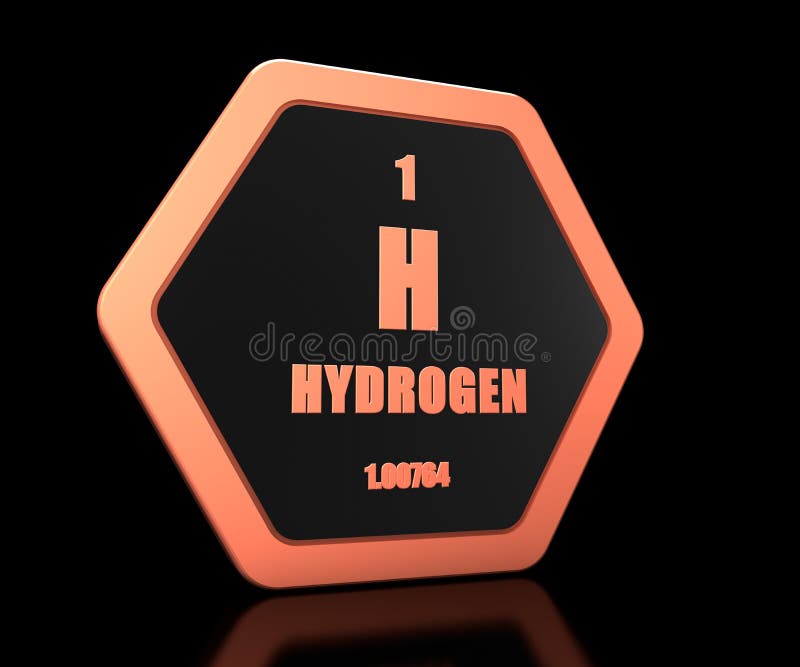
Hydroxide (OH–) is also known as the hydroxyl ion. Hydride (H: – ) also reacts with metals to form chemical compounds which are reducing agents.
Hydrogen symbol free#
The extra electron means that H- is not a free radical however it is not stable because this form of hydrogen is a very strong base (extremely alkaline) which reacts with water to produce hydroxide (OH –and molecular hydrogen (H 2). The two dots after the H means that this ion has two electrons instead of just one. That is why Hydride ion (H-) has the minus sign distinguishing it from a regular Hydrogen atom (H). This means that it is a negatively charged ion, or anion. Hydride is a hydrogen atom which has an extra electron. The H + hydrogen ion is the basis of the pH scale. This is the form of Hydrogen that produces the ATP enzyme that powers our cells and mitochondria. It becomes the positively charged hydrogen ion known as H +. When the Hydrogen atom loses an electron all that is left is a proton. Hydrogen gas cannot be kept in plastic because it will pass right through the walls of the container. That means it can go where nothing else can …including into your mitochondria which are the powerhouses of your cells. H2 is the smallest molecule in the universe. It is the antioxidant in ‘hydrogen-rich’ water. Consequently it is the most common form of Hydrogen because it is stable with a neutral charge.

H2 is also called molecular hydrogen.It consists of two protons and two electrons. H 2 is a gas which forms when two hydrogen atoms bond together and become a hydrogen molecule. The molecular form of hydrogen is more common.
.jpg)
However an atom of hydrogen rarely exists on its own because its unpaired electron eagerly seeks to join up with another electron. It consists of one proton and one unpaired electron which means that it is a free radical. Here is an attempt at clarification.Ītomic hydrogen is number 1 on the Periodic Table of Elements. Hydrogen: What’s the difference between H, H2, H+, H- and OH- ?ĭistinguishing between these different forms of Hydrogen can be confusing to those of us who flunked high school chemistry. Hydrogen is problematic in metallurgy because it can embrittle many metals, complicating the design of pipelines and storage tanks.WATER NEWS watermatters has moved! May 22nd, 2020 Most hydrogen is used near the site of its production, the two largest uses being fossil fuel processing (e.g., hydrocracking) and ammonia production, mostly for the fertilizer market. A small percentage is also produced using more energy-intensive methods such as the electrolysis of water. Industrial production is mainly from steam reforming of natural gas, oil reforming, or coal gasification. In 1766–1781, Henry Cavendish was the first to recognize that hydrogen gas was a discrete substance, and that it produces water when burned, the property for which it was later named: in Greek, hydrogen means "water-former". Hydrogen gas was first artificially produced in the early 16th century by the reaction of acids on metals. Because hydrogen is the only neutral atom for which the Schrödinger equation can be solved analytically, the study of its energetics and chemical bonding has played a key role in the development of quantum mechanics. The H + cation is simply a proton (symbol p) but its behavior in aqueous solutions and in ionic compounds involves screening of its electric charge by nearby polar molecules or anions. In ionic compounds, hydrogen can take the form of a negative charge (i.e., anion) where it is known as a hydride, or as a positively charged (i.e., cation) species denoted by the symbol H +. Hydrogen plays a particularly important role in acid–base reactions because these reactions usually involve the exchange of protons between soluble molecules. Hydrogen is nonmetallic, except at extremely high pressures, and readily forms a single covalent bond with most nonmetallic elements, forming compounds such as water and nearly all organic compounds. The emergence of neutral hydrogen atoms throughout the universe occurred about 370,000 years later during the recombination epoch, when the plasma had cooled enough for electrons to remain bound to protons. In the early universe, the formation of protons, the nuclei of hydrogen, occurred during the first second after the Big Bang.

For the most common isotope of hydrogen (symbol 1H) each atom has one proton, one electron, and no neutrons. Most of the hydrogen on Earth exists in molecular forms such as water and organic compounds.

Stars such as the Sun are mainly composed of hydrogen in the plasma state. Hydrogen is the most abundant chemical substance in the universe, constituting roughly 75% of all normal matter. It is colorless, odorless, tasteless, non-toxic, and highly combustible. At standard conditions hydrogen is a gas of diatomic molecules having the formula H 2. Hydrogen is the chemical element with the symbol H and atomic number 1.


 0 kommentar(er)
0 kommentar(er)
